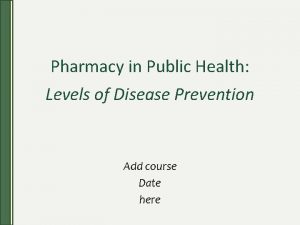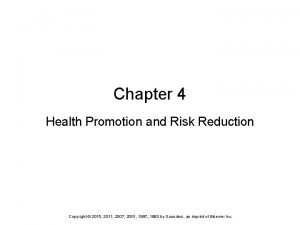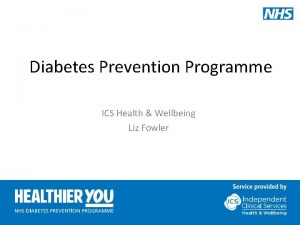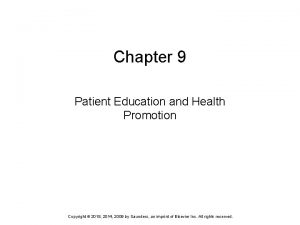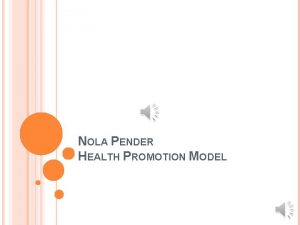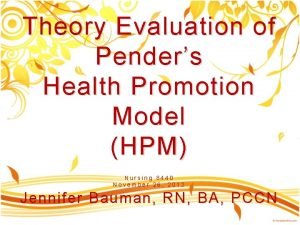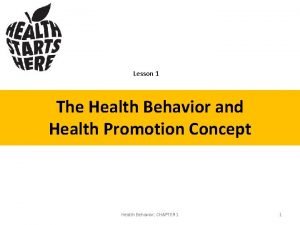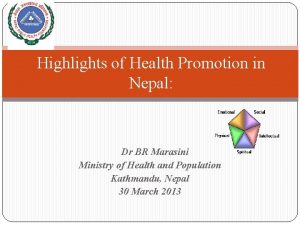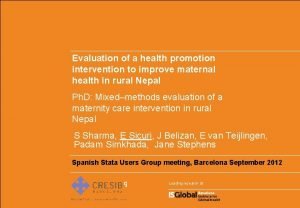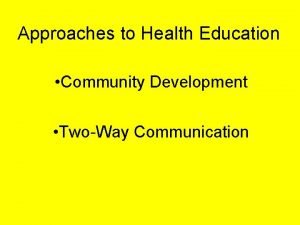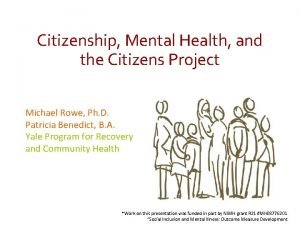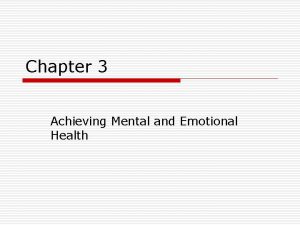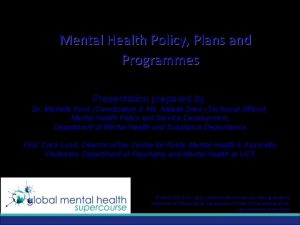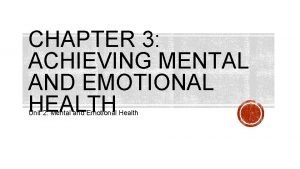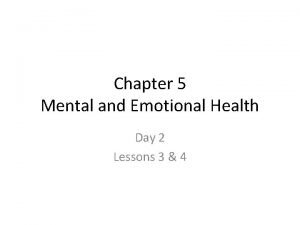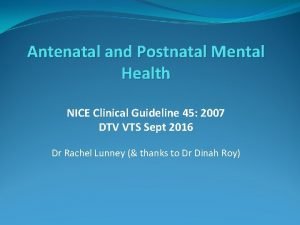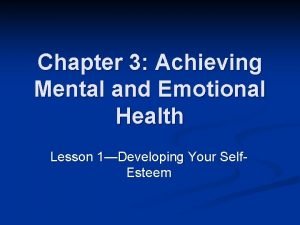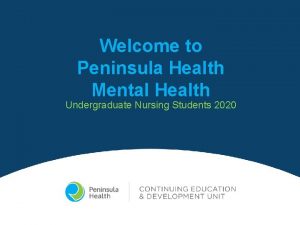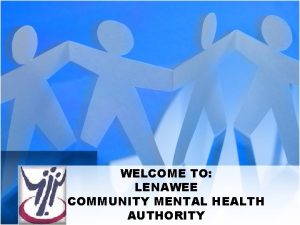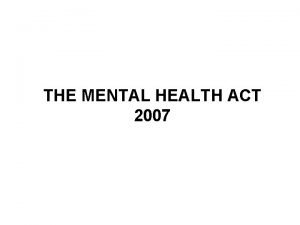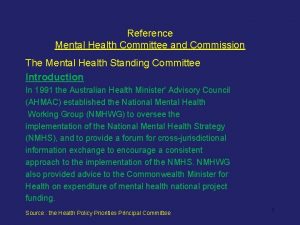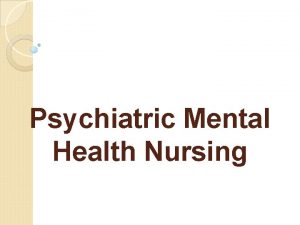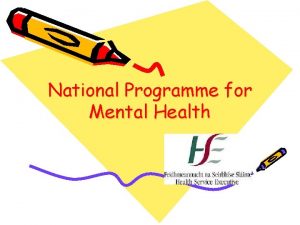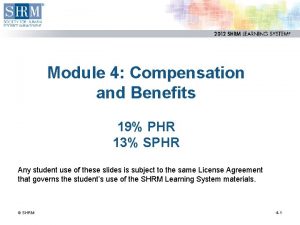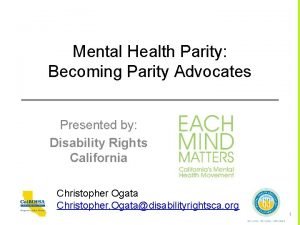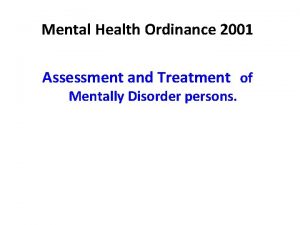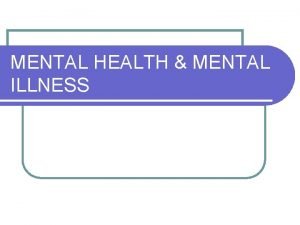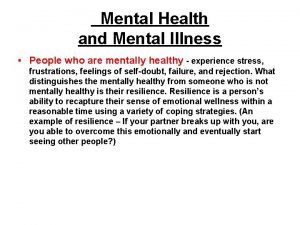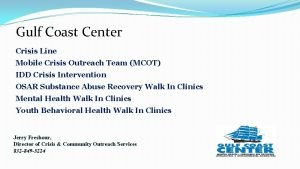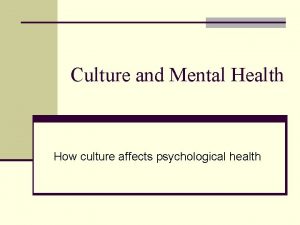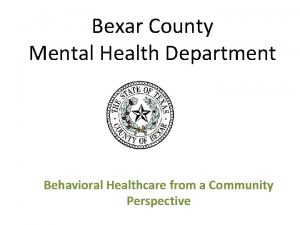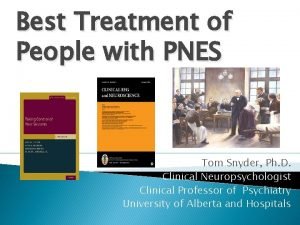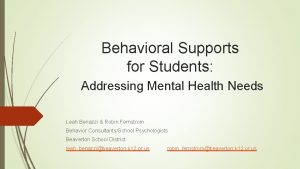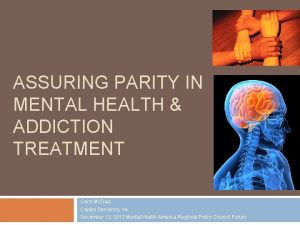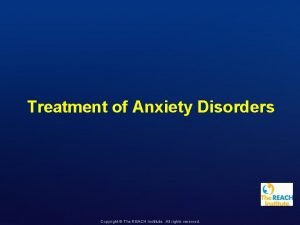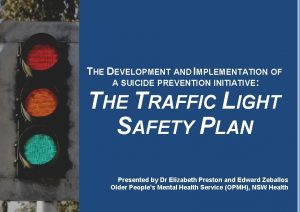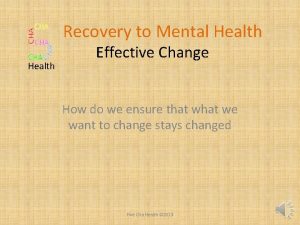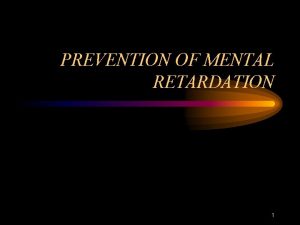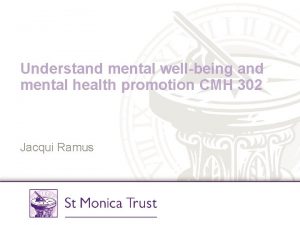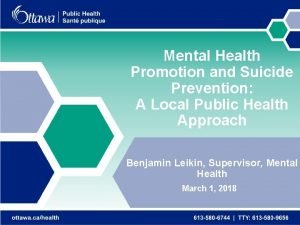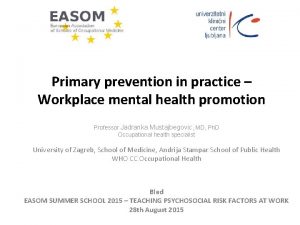Prevention and Promotion in Mental Health Progress Practices


































































































- Slides: 98

Prevention and Promotion in Mental Health Progress, Practices and Challenges Prof. dr. Clemens Hosman Radboud University Nijmegen and Maastricht University Dr. Gerard Molleman Manager Epidemiology and Public Health Nijmegen Public Health Institute The Netherlands

Major themes ¾ Mental health and behavioral disorders: important target for prevention and public health ¾ Prevention and health promotion: How is it organized in the Netherlands? ¾ Practice of prevention in mental health new challenges ¾ Quality management and evidence: collaboration between policy, practice and science ¾ Effects of preventive programs and MHP

1 Youth mental health and behavioral disorders: important target for prevention and public health

In Europe ± 1 out of 7 adults suffer from a mental disorder in a given year Recent European estimations point at 41 million suffering from anxiety disorders, 21 million from affective disorders, and almost 10 million from addictive disorders Many children are exposed to the burden of parental mental illness © Hosman Nijmegen Prevention Research Centre

Why priority for prevention in mental health? â Epidemic size of mental health disorders (15 -20%) â Further increase of prevalence expected â Serious impact on individual and social life â 40 to 50% don’t get professional treatment â Risk factor for serious physical diseases â Economic costs of mental illness are large â Good mental health has many individual, social, economic benefits â Society in general becomes more prevention-focused â Effective prevention programs are available Nijmegen Prevention Research Centre 2010

Costs in early adulthood from childhood conduct disorder Costs (£) from ages 10 to 28 Source: Scott, Knapp, Henderson, Maughan, BMJ 2001

Mental Health Related to many social problems Domestic Parenting violenve Bullying Aggression / violence Child abuse Work stress Producton loss Mental Health Mental Disorders Delinquency Addiction Physical diseases Loneliness School dropout School success Quality of life Povert Social-economical health differences Represents Social and Economic Capital

Mental health and prevention of mental-behav disorders = cornerstone of human, social and economic capital Prevention and promotion are wise investments while … Good mental health contributes to: § higher quality of life § better health and less mortality § better school achievements and less school drop out § higher productivity at work § more safe communities and less violence § significant cost reductions social security and justice Nijmegen Prevention Research Centre 2004

Prevention and Promotion in Mental Health…… …. an idea advocated for over more then 100 years Prevent incidence of mental disorders? Main reactions in the past: - Wishful thinking ! - Poorly defined field - Difficult to understand how to prevent - No scientific knowledge on causes - We do not know if it works Last 25 years major progress made

2010: Times have changed significantly…. Last 25 years major progress made … Insight in epidemic proportions of mental illness … Enough knowledge on causes to start acting in prevention … Wide range of prevention programs available … Many studies showing evidence on positive outcomes … Programs become disseminated and implemented

Functionally Related Fields of Public Health Prevention mental and behavioral disorders poor mental health Mental Health Promotion strengths & resilience © Hosman Nijmegen Prevention Research Centre

Subdivision of primary prevention: reducing incidence of mental disorders targeted at three levels of risk Individuals + symptoms no disorder Populations at increased risk Whole population Indicated prevention Selective prevention Universal prevention Nijmegen Maastricht Prevention Research Centre 2005

intervention Risik factors Nijmegen Maastricht Prevention Research Centre 2004 Factor 1 Factor 2 depression Factor 3 Factor 4 Disorder-specific prevention depression Child abuse intervention Domestic violence Broad spectrum prevention substance use agression suicide

Emotional intelligence What is Mental Health ? Positive affectivity Positive self esteem Feelings of mastery A cluster of mental and social capacities that people need Optimism to enhance their well-being, Self management to develop themselves mentally and physically, Stress management Creativity to create satisfying and respectful social and intimate relationships, Decision making To work productively and fruitfully Literacy to cope with the adversities and changes in life, and Problem solving Communication Social competence Social values & respect to reduce risk of serious problems and illness Nijmegen Maastricht Prevention Research Centre 2005

Many countries begin to change from a dominating care-focused mental health system towards more balance between care and prevention & promotion

2 Prevention and health promotion: How is it organized in the Netherlands? Nationally and Locally Dr. Gerard Molleman

3 Practice of prevention in mental health

Mental Health Promotion and Prevention in the Netherlands History Organization Themes Approaches

Prevention in mental health in the Netherlands Ø Ø Ø Started in 1970 Prevention departments of mental health centers Increasing pressure for quality Increasing pressure for qualit From trial-and-error to evidence-based programs From small to larger departments

Domains of MH prevention 1. Prevention departments of mental health centers – selective and indicated prevention 2. Wider group of organizations and professionals explicitly targeted at prevention and promotion in mental health 3. Organisations, professionals, community leaders and volunteers who’s work has beneficial impact at determinants of mental health All are essential

Mental Health Promotion and Prevention in the Netherlands Well-developed National Infrastructure for Prevention and Health Promotion mental health as a priority area National institutes And NGO’s Implementation by many organizations local level Primary health care Public health services Prevention and Health Promotion Teams Addiction clinics. 12/5/2020 Nijmegen Maastricht Prevention Research Centre 2005 Community mental health centres Parent education services Schools & companies Custody services.

Organization of prevention in the Netherlands 50 community mental health centers Each center has a prevention team Task: Development and implementation of programs to prevent serious mental illness Programs Children of mentally ill parents 12/5/2020 Parent education & child abuse Depression & Anxiety stress at work chronic disorders & family Mental health in elderly © Van Doesum & Hosman Prevention Research Centre Nijmegen University, 2000

A lot achieved in 40 years…… Nation-wide professionele MH-prevention sector Trained prevention experts (± 400) collaborating with many other professionals Large scientific knowledge base Focus at quality management and science-base Broad spectrum of prevention products Evidence-based programs + research projects National support systems and collaboration Links practice – policy – research centres International collaboration

Organizational context had large impact on development and identity of MH- prevention Development from mental health centers - Implications? Strong expertise in MH and psychiatry disorder prevention Person and family focused Care-related prevention Indicated and selective prevention Product-targeted culture Methods – courses, training, education, home visits

Mental disorders /problems depression and anxiety behavioral problems and bullying eating disorders psychosis sucide Mental health resilience and problem solving social competence (school) stress managemental capital Populations at risk COPMI: transmission paren child family members uemployed migrants Social determinants domestic vilence bullying parenting competence social support and social isolation Identity field of MH-prevention International and Partly national On all these topics Evidence of significant effects of prevention programs Hosman PRC Nijmegen Maastricht 2010

Important trends and innovations Two Tracks (1) prevention + care (stepped care) (2) public health + health promotion Strategic Strong increase of E-prevention - internet More community approach Collaboration with primary care and social systems From ‘interventions’ to integral approach - Address Clusters of related problems - Early life focus Organisation Merging of organizations and larger scales Integration Mental health and addiction Intersectorial coordianation Hosman PRC Nijmegen Maastricht 2010

Two-Track Policy Prevention part of stepped care health promotion and prevention integrated in communities Hosman PRC Nijmegen Maastricht 2010

‘Stepped Care’ in prevention by outpatient clinics Large-scale Public Mental Health Education universal and selective prevention through media & materials Short interventions for groups at risk selective prevention Intensive prevention programs indicated prevention for those at high risk For example: Early detection & treatment secondary prevention Parenting problems Use of Alcohol and drugs Nijmegen Prevention Research Centre 2005

Internet KOPPstoring (E-health) Play-talk groups Information Mass media Support groups Brochures and video’s Early treatment Child Parents Early treatment Foster homes Child Parents Foster homes Buddy system Additional support persons support. Family persons Family organizations School mental organizations health education School mental Mass media health education approach Mass media approach Network Professionals Community Policy, Advocacy, Budgeting Early treatment Mother-Baby Mother-baby intervention Parent training Psycho-educ family educational family program Support Groups Brochures and Brochures/Videos Video’s Postgraduate training Postgraduate Education training Screening Education instruments Screening Protocol&training Case-management Consultation Primary care Consultation Conferences Multi-component approach in prevention for children of mentally ill parents Comprehensive Multi-component approach in prevention for children of mentally ill parents in The Netherlands © Hosman & Van Doesum, Prevention Research Centre, Nijmegen University 2001

Important trends and innovations Two Tracks (1) prevention + care (stepped care) (2) public health + health promotion Strategic Strong increase of E-prevention - internet More community approach Collaboration with primary care and social systems From ‘interventions’ to integral approach - Address Clusters of related problems - Early life focus Organisation Merging of organizations and larger scales Integration Mental health and addiction Intersectorial coordianation Hosman PRC Nijmegen Maastricht 2010


Challenges Increasing reach Link physical, mental and social health More impact on environment To comprehensive approaches More evaluation and monitoring Cost effectiveness Stronger public health impact Hosman PRC Nijmegen Maastricht 2010

Finding and Common Preventive Approach ‘smart clusters’ of related problems Stress Exercise Depression Imune system Nutrician (Increase) Overweight Diabetes Cardiovascular diseases Alcohol smoking Nijmegen Maastricht URBAN 40 studie: Invloed wijkkenmerken Prevention Research Centre 2010

Many effective prevention programs available Access to effective programs through dozens of national and international databases Mental health; Social Emotional Learning; Suicide; Violence & Delinquency; substance Family & Parenting; School-based programs US-SAMSHA http: //www. modelprograms. samhsa. gov Europe http: //database. imhpa. net US-CASEL http: //www. casel. org/programs/selecting. php Netherlands http: //www. nji. nl

4 Quality management and evidence: collaboration between policy, practice and science Dr. Gerard Molleman

5 Effects of prevention and mental health promotion

What can we conclude about the effectiveness of prevention programmes in the mental health sector? effect management Nijmegen Prevention Research Centre 2004

Conclusions from outcome research g Many preventive interventions available g Can be effective and cost-effective g Diversity of preventive outcomes g Long term effects possible (15 years)

Prenatal - Early Infancy Project David Olds USA adolescent, low income pregnant women Home-visitation by nurses pregnancy ► 24 months • healthy life style • parent education • problem solving • social support • linkage to social network + health / social services Outcomes first 2 years Reduced smoking pregnancy 75% less preterm low birth weight In high risk mothers child abuse 19% 4% 32% fewer emergency-room visits Reduced use of welfare

Prenatal - Early Infancy Project David Olds USA Outcomes 3 rd and 4 th year Long term outcomes at age 15 40% less visits to physicians for injury and ingestion Less abuse and maltreatment 56% less likely alcohol and drugs problems 56% fewer arrests 81% fewer convictions 63% reduction in sexual partners Higher IQ score child 80% more involvement in work force (mothers) Benefit: $ 3. 313 per family

School-based programmes Repeated evidence for a broad range of positive outcomes Increase competence and resilience Decrease of social and coping skills problem behavior self esteem aggression prosocial behavior youth delinquency anger control smoking school achievement substance use depressive symptoms anxiety

Prevention Anxiety Disorders Dadds, Spence et al. , Australia School Children outcomes ( 7 -14 yrs ) with anxiety symptoms but no disorder Cognitive –behavioral 54% 16% and family-based group intervention 10 weeks % onset anxiety disorders in 6 months

Children of Divorce: Mother and Child Prevention Program Sandler, Wolchik et al. (2002) RCT, n = 218 Mother groups And child groups 11 group sessions 2 individual sessions Children: 8 -12 year Quality M - C relation Involving fathers Conflicts parents Discipline Effective coping Divorce stressors 23, 5% 11% Presence of mental disorders 6 years after intervention + less externalizing problems

Triple P Matthew Sanders, University of Queensland Professor of Clinical Psychology Positive Parenting Program Disseminated and Implemented across 17 Countries

Triple P Matthew Sanders, University of Queensland Goal Promoting Positive Parenting Preventing behavioural & emotional Problems Approach Public health approach : population wide Parents with children: pregnancy to 14 yrs Risk level Universal selective indicated Methods TV, books, lectures, groups, phone, individual Settings Media, (pre)school, primary health care, mental health services, workplace Themes Safe, positive environment; assertive discipline; realistic expectations; problem solving ……… Features Comprehensive, low access, minimal sufficiency

Levels of Intervention Universal Triple P Level One Selected Triple P Level Two Targets universal all p a r e n t s selected parents and children with minor problems Primary Care Triple P Level three Standard Triple P Level four Enhanced Triple P Level five indicated parents and children detectable problems secondary

Triple P: Evidence-based Outcomes over 40 controlled trials across different cultures PARENTS Ü Disfunctional parenting strategies (e. g. coercive) Ü Stress and Anger Ü Depression Û Well-being Û Parent’s relationship quality CHILDREN Ü Conduct problems Ü Child abuse Small to large effect sizes, sustainable 1 year follow up e. g. see meta-analyses by Novak & Heinrichs (2008), Graaf et al. (2008)

US Triple P System Population Trial Prinz, Sanders, Shapiro et al. (2009) Effects in number of cases per 1000 children aged 0 to 8 years P<. 0. 03 Substantiated child maltreatment cases Roughly 1 in 4 prevented P<. 0. 01 Out-of-home placements Also injuries significant reduced

social and economic benefits § youth delinquency § violence § loss productivity § cost welfare § low income § school achievement § social participation

Some recommendations for the Future To increase population impact of primary prevention: n Make systematically use of successful programs and replicate outcome studies n Make primary prevention an integral part of primary health care & mental health care through a stepped care strategy n Make “prevention and promotion in mental health” an integral part of mainstream public health and health promotion n Explore the opportunities for “win-win” strategies by linking primary prevention with social policies and human rights n Systematic capacity building for primary prevention and mental health promotion across professions, communities and public sectors



5 Effective programs New challenges

Promising developments and challenges § Interventions much earlier in life addressing early risk and protective factors § § Addressing clusters of related problems § Increasing reach: Making successfully use of internet (E-health) and self-help guides § § Community monitoring systems for prevention Community programmes & strategies: e. g. Communities that care Linking prevention and promotion with ( ) social policy, human rights and social justice Nijmegen Maastricht Prevention Research Centre 2007

The social Web of Depression relation between mental and social problems Calls Violence to women Poor for parenting a comprehensive Child abuse & Public neglect health Stress management approach School + Mental health + Social Policy failure Teenage parenthood Depression en Anxiety Children of mentally ill Work and disability Poverty Refugee status Chronic illnesses Nijmegen Prevention Research Centre 2004

Challenges for prevention mental disorders optional priority issues for WHO-CC 1. Strengthen epidemiological base of prevention 2. Link prevention with mental health promotion 3. Integrate prevention of mental disorders in public health, health promotion and social policies 4. Develop expertise, policy models & tools for local management of integrated prevention approaches 5. Develop intervention methods with large reach 6. Focus on prioritized prevention / MHP themes Healthy start of life; school-based programs; work & economy 7. Invest in build professional capacity across organizations and settings 8. Enhance dissemination of knowledge & programs Nijmegen Prevention Research Centre 2009

Key Challenges for Next Decade 1 Widen the Spectrum of Outcomes by Combining Prevention and Mental Health Promotion Approaches 2 Develop a standardized system of outcomes and indicators 3 Increase Reach and Impact in Society e. g. internet, public policies, legislation, dissemination 4 Address and Understand Clusters of Related Problems and Develop a Coalition with Health Promotion 5 Study Impact of Social Determinants on Individual Risk and Protective factors (life span) and Opportunities for Change e. g. relate with social policies, human rights 6 Mental Health Monitoring & MH Impact Assessment 7 Economic Evaluation of Mental Health, Prevention, Promotion 8 Building Local & State Infrastructures for Implementation Hosman, PRC, Universities of Nijmegen and Maastricht 2007

Trend ► multicomponent packages examples n Triple P: multi-level Positive Parenting Program n Communities that Care: Youth Externaling n Multicomponent, multi year school programs n Stepped Care: Depression Prevention

Innovative developments Where to find solutions for current limitations Use new methods to improve reach in population n Make more use of internet and mass media n Stepped Preventive Care strategy with low- budget and easily accessible methods for the groups with the lowest risk / need. n Use community approaches, and influence those who have some control over social risk factors that impact many people.

Options for Innovation Where to find solutions for current limitations Increase efficiency and effectiveness of programs n More focus on common factors with a long term broad spectrum impact, e. g. child abuse, poor parenting, social-emotional skills… n Do not solve each problem separately, address clusters of narrowly related problems. Try to understand use their interrelations

E-health - Internet prevention è Fast growing availability of internet-based availabilit prevention and treatment programs è Higher accessibility among youngsters è Evidence of effectiveness è Cost-effective and larger reach



Trend towards ‘Evidence-based’ practices Evidence-based practice, as common in medical practice, is also becoming the standard in prevention and health promotion worldwide Evidence-based means, 1. policies and practices are based on epidemiological knowledge and research of risk and protective factors 2. interventions could provide solid evidence that they are effective and cost-effective.

To evaluate outcomes of preventive programs we need to apply multiple evaluation criteria 1. Effectiveness § Effective? No effect? Negative effects? § Strength of the effect § Duration: sustainable effects? § Reach: For which part of target population? 2. Quality of Evidence How biased are conclusions? 3. Relevance Value for each involved party?

Why are evaluation and ‘evidence-based’ practices in prevention so important? ¾ Crucial feedback for improving prevention programs and stop programs that don’t work ¾ Selection: which programs work best? ¾ Efficiency: use of scarce resources for prevention ¾ Accountability: to justify use of public money ¾ To get community support and participation ¾ To get funding for prevention practices ¾ Professional quality: Effectiveness is essential

How to create a productive link between science, policy and practice? Our experiences at national and local level Ø National level Ø l l Setting priorities research and development program: knowledge, programs and implementation Databases Money for implementing prevention practice only for intervention programs with evidence-based effects or based on evidence-based principles

How to create a productive link between science, policy and practice? Ø Local level

Trends and challenges

Research & Development Evidence-based Dissemination & Advocacy Programs & Services implement preventive effects Policy & Organization in populations Training & Capacity Building a System of Conditions for Effective Prevention & Promotion in Mental Health © Nijmegen Prevention Research Centre 2009

Standards of evidence database

Treatment Gap Western Europe Ø Major depression: 45. 4% Ø Alcohol dependence: 92. 4% Ø Psychosis: Ø Bipolar Ø Panic disorder: 39. 9% disorder: 47. 2% Ø Anxiety Kohn 2004 17. 8% disorder: 62. 3%

E-health and prevention Ø Ø Ø Ø Cursus of e-mailcoaching via internet: www. alcoholondercontrole. nl www. boulimiadebaas. nl www. cannabisondercontrole. nl www. drugsondercontrole. nl www. eetbuienondercontrole. nl www. familievan. nl www. gokkenondercontrole. nl www. gripopjedip. nl www. internetondercontrole. nl www. kleurjeleven. nl www. rokenondercontrole. nl Behandeling via internet is mogelijk via www. interapy. nl. Daarnaast bieden verschillende GGZ-instellingen die participeren in Indigo ook online behandelaanbod, zoals: www. mijnparnassia. nl

Cursussen Parnassia Ø Ø Ø Ø Assertiviteit Stoppen met piekeren en negatief denken In de put, uit de put Somber of gespannen Omgaan met stress Meer zelfvertrouwen Liever bewegen dan moe Bewegen geeft kracht (voor migrante mannen) Hellup, mijn kind kan niet zonder Mijn kind, alcohol en drugs Chronisch zieken Ondersteuningsgroep nabestaanden na zelfdoding Terug naar het overzicht

Parnassia Ø Preventie: Stress Ø Ø Preventie: Depressie Preventie: Alcohol, drugs en gokken Preventie: Kinderen van patiënten Terug naar het overzicht

Developments Ø focussing on prioritized issues

Which parties are involved in prevention and mental health promotion? Ø

Generating resources and capacity for prevention and health promotion Integrating prevention in the professional activities of existing services Ø Experts Ø


Support Coalition f. Or Prevention KOP


Challenges





Effectiness of prevention

Support of National Institutes to local prevention practices Factsheets and databases with supporting information: epidemiological data on major problems, risk factors Ø Standardization Ø Providing models for local prevention planning Ø

Final conclusions ► Prevention is highly needed: Given the high prevalence of mental disorders, their huge social and economic costs, and lack of treatment capacity ► Preventive interventions generate a wide range of significant effects, also social + economic benefits ► Share knowledge on successful and unsuccessful preventive practices, and learn to understand the principles of effective prevention ► Collaboration between research-practice-policy to implement and adapt interventions that work, to develop new programs, and improve effectiveness Nijmegen Maastricht Prevention Research Centre 2006


Division of tasks in prevention and

Concepts of mental health ¾ documents EU en WHO ¾ mental health and mental disders ¾ mental health and addiction ¾ catogorical versus dimensional view ¾ attention to subclinical ‘disorders’ ¾ clusters of related problems


EU and mental health The mental health of the European population is a resource for the attainment of some of the EU’s strategic policy objectives, such as to put Europe back on the path to long-term prosperity, to sustain Europe’s commitment to solidarity and social justice, and to bring tangible practical benefits to the quality of life for European citizens 1. Mental health of the EU population can be considerably improved: • Mental ill health affects every fourth citizen and can lead to suicide, a cause of too many deaths; • Mental ill health causes significant losses and burdens to the economic, social, educational as well as criminal and justice systems;

EU Green paper on Mental Health (2005) Mental health, mental ill health and its determinants: The WHO describes mental health as: “a state of well-being in which the individual realizes his or her abilities, can cope with the normal stresses of life, can work productively and fruitfully, and is able to make a contribution to his or her community” 2. Mental ill health includes mental health problems and strain, impaired functioning associated with distress, symptoms, and diagnosable mental disorders, such as schizophrenia and depression. The mental condition of people is determined by a multiplicity of factors (annex 1), including biological (e. g. , genetics, gender), individual (e. g. , personal experiences), family and social (e. g. , social support) and economic and environmental (e. g. , social status and living conditions).

Major strategies for capacity building and expertise development 1. Training & Learning systems 2. Involving new personnel, disciplines and stakeholder organizations 3. Setting professional standards across disciplines for providing MHP/prevention 4. Coalition building & Advocacy: national & local Hosman PRC Nijmegen Maastricht 2007


 Primary prevention secondary prevention tertiary prevention
Primary prevention secondary prevention tertiary prevention Health promotion and levels of disease prevention
Health promotion and levels of disease prevention Health promotion and levels of disease prevention
Health promotion and levels of disease prevention Mental health and mental illness chapter 20
Mental health and mental illness chapter 20 Physical progress and financial progress
Physical progress and financial progress Differences between health education and health promotion
Differences between health education and health promotion Jeopardy mental health
Jeopardy mental health Health promotion and maintenance
Health promotion and maintenance Ucf health sciences health promotion track
Ucf health sciences health promotion track Ics health & wellbeing
Ics health & wellbeing 5 approaches to health promotion
5 approaches to health promotion Patient readiness to learn
Patient readiness to learn Caplan and holland model of health promotion
Caplan and holland model of health promotion Definisi promosi kesehatan adalah
Definisi promosi kesehatan adalah Nola pender health promotion model example
Nola pender health promotion model example Health promotion methods
Health promotion methods Health promotion theories
Health promotion theories Professional nursing practice 7th edition
Professional nursing practice 7th edition Jessica konopka
Jessica konopka Health promotion emblem
Health promotion emblem Five ethics in health promotion
Five ethics in health promotion Health promotion program in malaysia
Health promotion program in malaysia Who health promotion glossary
Who health promotion glossary Ottawa charter of health promotion
Ottawa charter of health promotion Define health promotion
Define health promotion Ottawa charter emblem
Ottawa charter emblem Health promotion cycle
Health promotion cycle Chicago partnership for health promotion
Chicago partnership for health promotion Social justice principles pdhpe
Social justice principles pdhpe Two way communication health promotion
Two way communication health promotion The intentional use of unfriendly or offensive behavior
The intentional use of unfriendly or offensive behavior Mental health and older adults
Mental health and older adults Law enforcement mental health and wellness act
Law enforcement mental health and wellness act Mental health and older adults
Mental health and older adults Mental health and citizenship
Mental health and citizenship Chapter 3 achieving mental and emotional health
Chapter 3 achieving mental and emotional health Chapter 21 mental health diseases and disorders
Chapter 21 mental health diseases and disorders Chapter 3 mental and emotional health answer key
Chapter 3 mental and emotional health answer key Psychology, mental health and distress
Psychology, mental health and distress Mental health policy, plans and programmes michelle funk
Mental health policy, plans and programmes michelle funk Glencoe health chapter 3
Glencoe health chapter 3 Chapter 5 lesson 2 mental disorders
Chapter 5 lesson 2 mental disorders Chapter 3 achieving mental and emotional health
Chapter 3 achieving mental and emotional health Chapter 3 achieving mental and emotional health
Chapter 3 achieving mental and emotional health Emotional health defintion
Emotional health defintion Achieving mental and emotional health
Achieving mental and emotional health Mind map on mental health
Mind map on mental health Nice antenatal and postnatal mental health
Nice antenatal and postnatal mental health Chapter 3 mental and emotional health
Chapter 3 mental and emotional health Chapter 3 achieving mental and emotional health
Chapter 3 achieving mental and emotional health Chapter 3 achieving mental and emotional health
Chapter 3 achieving mental and emotional health Chapter 3 achieving mental and emotional health
Chapter 3 achieving mental and emotional health Chapter 3 achieving mental and emotional health
Chapter 3 achieving mental and emotional health Chapter 15 achieving mental and emotional health
Chapter 15 achieving mental and emotional health Health maintenance practices
Health maintenance practices Health and social care component 3
Health and social care component 3 Progress and performance measurement and evaluation
Progress and performance measurement and evaluation Progress and performance measurement and evaluation
Progress and performance measurement and evaluation Met call
Met call Lenawee county cmh
Lenawee county cmh Van buren cmh
Van buren cmh Together for mental health
Together for mental health Mental health act 2007 pdf
Mental health act 2007 pdf Health triangle project
Health triangle project Introduction to mental health awareness presentation
Introduction to mental health awareness presentation Mental health committee
Mental health committee Wellness in mind nottingham
Wellness in mind nottingham Mental health nursing definition according to who
Mental health nursing definition according to who Ineffective childbearing process example
Ineffective childbearing process example Mental health programme
Mental health programme Objectives of community mental health
Objectives of community mental health Benefits of phr
Benefits of phr Roadmap to success
Roadmap to success Toolbox talk mental health
Toolbox talk mental health Mental health documentation training
Mental health documentation training Mental health equity
Mental health equity Mental health ordinance
Mental health ordinance Schizophrenia def
Schizophrenia def Mental health learning objectives
Mental health learning objectives Mental health problems examples
Mental health problems examples Objective for mental health awareness
Objective for mental health awareness Poem on mental health awareness day
Poem on mental health awareness day Health and wellness trivia
Health and wellness trivia Billy corgan mental health
Billy corgan mental health Mental health america of san diego county
Mental health america of san diego county Individual service plans
Individual service plans How sport affects health
How sport affects health Gulf coast center mental health
Gulf coast center mental health Influence of culture on mental health
Influence of culture on mental health Bexar county mental health services
Bexar county mental health services Thomas snyder mental health
Thomas snyder mental health Mental health skill building interventions examples
Mental health skill building interventions examples Mental health equity
Mental health equity Reach institute mental health
Reach institute mental health Mental health connection of tarrant county
Mental health connection of tarrant county Traffic light safety plan mental health
Traffic light safety plan mental health Northern nevada adult mental health
Northern nevada adult mental health Steps to mental health recovery
Steps to mental health recovery Pet therapy for mental health
Pet therapy for mental health

